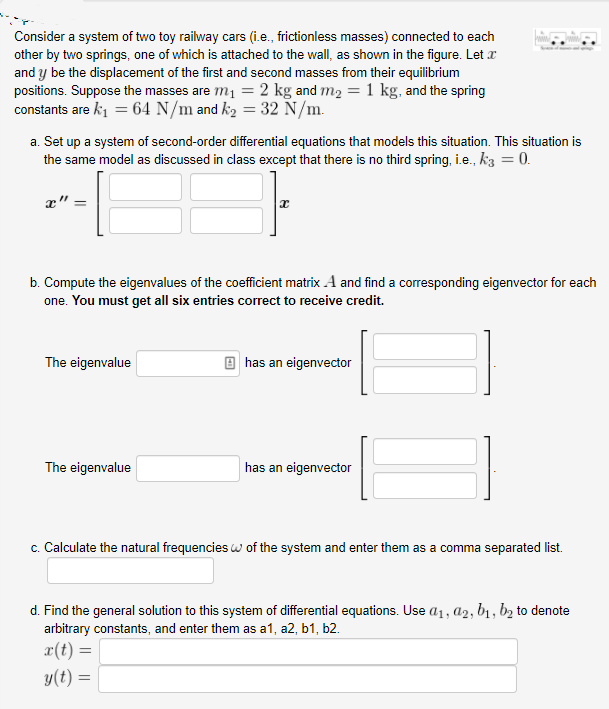Consider a system of two toy railway cars (i.e., frictionless masses) connected to each other by two springs, one of which is attached to the wall, as shown in the figure. Let x and y be the displacement of the first and second masses from their equilibrium positions. Suppose the masses are m1 = 2 kg and m2 = 1 kg, and the spring constants are ki = 64 N/m and k2 = 32 N/m. a. Set up a system of second-order differential equations that models this situation. This situation is the same model as discussed in class except that there is no third spring, i.e., kz = 0. b. Compute the eigenvalues of the coefficient matrix A and find a corresponding eigenvector for each one. You must get all six entries correct to receive credit.
Consider a system of two toy railway cars (i.e., frictionless masses) connected to each other by two springs, one of which is attached to the wall, as shown in the figure. Let x and y be the displacement of the first and second masses from their equilibrium positions. Suppose the masses are m1 = 2 kg and m2 = 1 kg, and the spring constants are ki = 64 N/m and k2 = 32 N/m. a. Set up a system of second-order differential equations that models this situation. This situation is the same model as discussed in class except that there is no third spring, i.e., kz = 0. b. Compute the eigenvalues of the coefficient matrix A and find a corresponding eigenvector for each one. You must get all six entries correct to receive credit.
Linear Algebra: A Modern Introduction
4th Edition
ISBN:9781285463247
Author:David Poole
Publisher:David Poole
Chapter2: Systems Of Linear Equations
Section2.5: Iterative Methods For Solving Linear Systems
Problem 25EQ
Related questions
Question
(please solve within 15 minutes I will give thumbs up)

Transcribed Image Text:Consider a system of two toy railway cars (i.e., frictionless masses) connected to each
other by two springs, one of which is attached to the wall, as shown in the figure. Let x
and y be the displacement of the first and second masses from their equilibrium
positions. Suppose the masses are m1 = 2 kg and m2 = 1 kg, and the spring
constants are k1 = 64 N/m and k2 = 32 Ñ/m.
a. Set up a system of second-order differential equations that models this situation. This situation is
the same model as discussed in class except that there is no third spring, i.e., k3 = 0.
x"
b. Compute the eigenvalues of the coefficient matrix A and find a corresponding eigenvector for each
one. You must get all six entries correct to receive credit.
The eigenvalue
O has an eigenvector
The eigenvalue
has an eigenvector
c. Calculate the natural frequencies w of the system and enter them as a comma separated list.
d. Find the general solution to this system of differential equations. Use a1, a2, b1 , b2 to denote
arbitrary constants, and enter them as a1, a2, b1, b2.
x(t) =
y(t) =
Expert Solution
This question has been solved!
Explore an expertly crafted, step-by-step solution for a thorough understanding of key concepts.
This is a popular solution!
Trending now
This is a popular solution!
Step by step
Solved in 6 steps with 3 images

Recommended textbooks for you

Linear Algebra: A Modern Introduction
Algebra
ISBN:
9781285463247
Author:
David Poole
Publisher:
Cengage Learning

Linear Algebra: A Modern Introduction
Algebra
ISBN:
9781285463247
Author:
David Poole
Publisher:
Cengage Learning